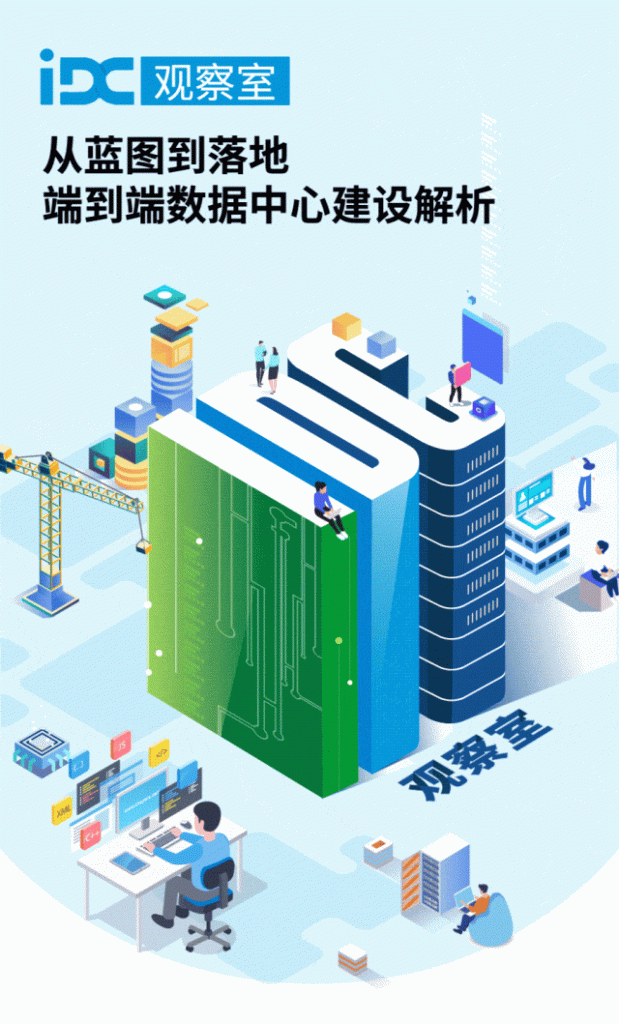
Introduction:
Data centers serve as the digital foundation of the digital economy and intelligent development. A well-planned data center can provide enterprises with efficient, secure, and reliable data storage and processing services. In this article, we delve into the entire process of data center design, construction, and operation, focusing on the underlying design logic of end-to-end data centers.
The Digital Foundation for Intelligent Development
As one of the key infrastructures of the digital economy, data centers provide a stable operating environment and powerful computing capabilities for various digital businesses. Their development has also facilitated the adoption and application of cloud computing, enabling enterprises and organizations to more easily access and utilize computing resources, providing strong support for big data analytics and AI applications, driving business innovation and intelligent decision-making.
In 2021, the National Development and Reform Commission, along with the Cyberspace Administration of China and other departments, issued the Guiding Opinions on Accelerating the Construction of a National Integrated Big Data Center Collaborative Innovation System. It highlighted that as the pace of digital transformation across industries accelerates, the total amount of data in society is growing explosively. This has significantly increased the demand for data storage, computing, and application resources, creating an urgent need to promote the rational layout, supply-demand balance, green and intensive development, and interconnectivity of data centers. The goal is to build a new computing power network system that integrates data centers, cloud computing, and big data, thus facilitating the circulation and application of data elements and achieving green, high-quality development of data centers.
In recent years, the rapid development of artificial intelligence (AI) has led to a sharp increase in demand for computing power, especially with the rise of generative AI, which requires strong data processing capabilities and storage capacity. This presents significant growth potential for data centers, but also introduces new challenges. According to Grand View Research, the global data center construction market was valued at approximately USD 213. 5 billion in 2022. It is expected to expand to USD 371. 9 billion by 2030, growing at a compound annual growth rate (CAGR) of 7. 4%.
Key Elements of Large-Scale Data Center Construction
Data center construction is a critical process that requires comprehensive planning and consideration of various requirements. Data centers house a large amount of hardware, network facilities, and software systems. The technology involved is complex and requires proper design, installation, and testing to ensure compatibility, efficient operation, and security.
As availability, security, service capacity, computing efficiency, and green, low-carbon standards become common global goals for data centers, the following five factors must be considered during the construction process:需要考虑以下五个方面的因素:
Scale and Capacity: Data centers must handle large-scale information flow, which requires substantial hardware infrastructure. This involves integrated planning for buildings, equipment, power supply, cooling, and networks to meet the demands for high density and availability.
Security and Stability: Given the sensitivity of data stored in data centers, security and stability are crucial. Measures must be taken to ensure safe storage and transmission of data and to guard against both physical and cyber security threats. In certain cases, businesses may require more customized security solutions.
Energy Efficiency and Environmental Requirements: With rising energy costs and growing environmental awareness, data center construction must meet energy-saving, green, and environmentally friendly standards. This is particularly important as demand for hyperscale data centers grows, necessitating reduced energy consumption, water use, and carbon emissions.
Disaster Recovery and Backup Planning: Robust disaster recovery planning and technology are essential to mitigate risks posed by natural disasters, hardware failures, or human errors. In some cases, customized solutions may be necessary to meet specific business needs.
Monitoring and Management Systems: Comprehensive monitoring systems ensure the stable operation of equipment, timely resolution of issues, and continuous performance optimization.
In February 2023, the Central Committee of the Communist Party of China and the State Council issued the Overall Layout Plan for the Construction of Digital China, which emphasized the need for a systematic optimization of computing power infrastructure. The plan aims to promote the efficient complementarity and coordinated interaction of computing resources between the eastern and western regions of China, while guiding the rational and tiered layout of general data centers, supercomputing centers, intelligent computing centers, and edge data centers. This suggests that building various types of data centers has become an irreversible trend, as different industries and application scenarios have diverse requirements. For example, industries such as finance and telecommunications have higher demands for security and stability in data centers, while fields like the internet and artificial intelligence require greater computing power and flexibility.
Built-to-suit data centers, with a rational tiered layout and diversified services, can better meet the varying needs of different sectors. Thus, it can be said that rational planning and proper customization are the two key elements in current data center construction. The two complement each other: rational planning provides the foundation and framework for appropriate customization, while customization tailors the design and configuration to specific business needs based on the planning.
Facing numerous challenges, where is large-scale data center construction headed?
A well-planned data center can provide enterprises with efficient, secure, and reliable data storage and processing capabilities, which is crucial for digital and intelligent development. However, given that data centers consist of numerous hardware systems, including coolers, power distribution equipment, and environmental monitoring systems, it is no simple task to ensure all hardware standards are met and the project is completed before servers and network devices are moved in.
According to the 2023 Global Data Center Survey published by Uptime Institute in July 2023, more than half of operators experienced site outages over the past three years, although this is the lowest recorded figure to date, continuing a trend of steady improvement. Additionally, data center operators are facing stricter regulations, greater pressure to improve energy efficiency, as well as ongoing staffing and supply chain challenges. The underlying causes of these issues stem from common pitfalls in data center construction: lack of planning, overlooking flexibility or scalability, neglecting security, and a shortage of professional expertise.
To prevent and address these issues, an end-to-end approach to data center construction — from design to construction to operation — is crucial, particularly for large-scale data centers. This approach ensures consistency, performance, and security across all stages to meet business needs and prepare for future challenges.
Firstly, an end-to-end approach ensures consistency and coordination throughout the entire construction process. Design, construction, and operation are different stages of the data center lifecycle, but they are closely interconnected and mutually influence one another. Hyper-scale data centers handle vast amounts of data, often spanning multiple physical locations. End-to-end solutions help large-scale data centers manage complex data flows by ensuring consistency and integrity from the source to the destination. By adopting an end-to-end approach, each stage takes into account the requirements of other stages, ensuring that all aspects of the large-scale data center are coordinated and supported.
Secondly, an end-to-end approach ensures that the design, construction, and operation of the data center align with business needs and optimize resources. By integrating various stages, future operational requirements can be considered during the design phase, making the construction process more tailored to actual needs and avoiding wasteful and unnecessary investments. Moreover, an end-to-end design optimizes the performance of large-scale data centers, reducing latency caused by large data flows, increasing data throughput, and more efficiently utilizing network and storage resources.
Additionally, the end-to-end approach embeds risk management and disaster recovery planning throughout the entire data center lifecycle. From the design phase, potential risks are considered, strengthening fault tolerance and disaster recovery strategies for hyper-scale data centers, with appropriate security measures and disaster recovery plans implemented during construction. The management and monitoring of large-scale data centers require high flexibility. End-to-end solutions simplify data flows and reduce system complexity, enabling continuous monitoring and optimization of system security and stability during operations.
Finally, the end-to-end approach encourages continuous optimization and innovation throughout the data center’s lifecycle. Since the construction of large-scale data centers is a long-term process, each phase provides opportunities to evaluate and improve existing design and operational strategies. Through an end-to-end approach, builders can continually seek better solutions and technological innovations to adapt to rapidly changing business environments and technological trends.
A Single Organization Implementing the End-to-End Approach
Even though the end-to-end data center construction plan can better prepare for future challenges, when it comes to actual project implementation, some users may, for various reasons, choose to involve multiple suppliers to execute the plan. This could lead to a series of issues, ultimately preventing the solution from being effectively implemented and failing to achieve the original intent of adopting an end-to-end solution.
First, when multiple organizations are involved in data center construction, communication and coordination issues may arise, leading to misunderstandings that slow down or derail the project. Second, it becomes difficult to assign responsibility, and when problems occur, it can be hard to identify the responsible party. This can lead to inefficient problem resolution, or even the concealment of mistakes to avoid blame. Third, different organizations may use inconsistent technical standards, potentially leading to system compatibility issues. Finally, data sharing and exchange between multiple organizations may raise security and privacy concerns.
On the other hand, when a single organization is responsible for the design, construction, and operation of a data center, communication is much smoother, with all teams working towards the same goal under common standards and protocols. This greatly improves construction and operational efficiency, reduces errors, and enhances overall quality control in the data center. Additionally, having a single organization responsible ensures that any issues arising during the construction or operation of the data center have a clear point of accountability. Any problems or demands can be addressed promptly, reducing the duration of failures and maximizing the reliability of the data center.。
Of course, a single organization managing the design, construction, and operation of a data center is not without its risks, such as a potential lack of innovation or competition. Therefore, it is necessary to thoroughly evaluate a partner’s experience, expertise, technical capability, project management skills, service quality, cost-effectiveness, reputation, and ability to safeguard security and privacy.
Chayora is committed to providing exceptional customer service, with extensive knowledge and experience in built-to-suit data center solutions. It offers comprehensive end-to-end capabilities, from design to construction to operation. Through its global platform in partnership with EdgeConneX , Chayora enables clients to quickly access over 50 popular markets across Asia and globally, ensuring access to diverse international resources for data center construction and operations. With outstanding design, planning, and construction capabilities, Chayora delivers build-to-suit data center solutions that align closely with clients' business needs in a fast, cost-effective, and efficient manner, while also providing premium operational services. This fully meets clients' business demands and supports enterprises in achieving digital transformation.
The demand for large language models and artificial intelligence (AI) continues to grow. However, whether it’s for providing the computing power needed for model training or the output of AI capabilities, strong data center infrastructure is essential. The end-to-end data center construction model, where a single organization is responsible for design, construction, and operation, allows for the creation of safer, more efficient, and more flexible data centers. This lays a solid foundation for businesses' digital transformation, enabling them to excel in the AI era, led by generative AI.
1302, 13/F, Spaces Sun House, 90 Connaught Road Central, Sheung Wan, Hong Kong
+852 3653 5268
RM01-06,Level 24 China World Trade Center Office 2 No.1 Jianguomenwai Avenue
Chaoyang District
Beijing, China, 100004
RM116, Level 15 Yuesheng Mansion No.1 Wuning Road South Jing'An District
Shanghai, China, 200042
